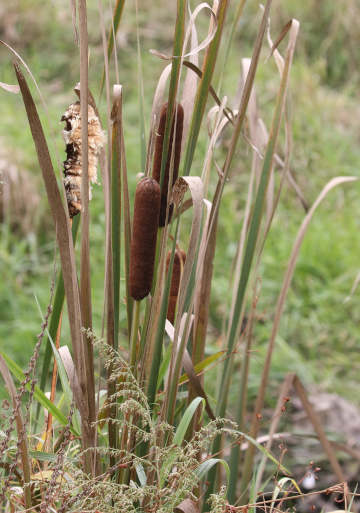Village News

PHOTO COURTESY OF GARRY KESSLER
Cattails
November 19, 2021
NATURE NOTES
By Annie Reid
Westborough Community Land Trust
Cattails going to fluff
As the leaves come down, we begin to notice plants such as cattails that will persist into winter and perhaps until spring. Native cattails have long provided food, shelter, medicine, and more to wildlife and even humans.
Cattails look scraggly at this time of year, but you can recognize them in stands in shallow water in marshes, retention basins, and pond edges. Their thick, brown, sausage-like flowerheads and narrow, sword-like leaves are distinctive. Yes, those hot-dog-like clubs are actually flowerheads, densely packed with flowers that don’t bear petals. They’re not the part anyone would eat. Now some are already going to fluff, turning into unkempt, tan, cottony down that will fall apart and carry tiny seeds on the breezes. As fall and winter progress, more and more will turn to fluff. The cattail leaves, 3-5 feet tall, turn brown but stand stiffly into the winter, giving cattail marshes a unique look in the snow.
Most of the cattails we see are broad-leaf cattail (Typha latifolia), but some places have narrow-leaf cattail (Typha angustafolia). It has narrower leaves and is not native to New England.
Who eats cattails? Many wild animals do. Chief among them are muskrats, found in local marshes and ponds year-round. They dive to the muddy bottom for the starchy cattail rhizomes (underground stems). In spring they also munch on new green stems. Fish nibble the rhizomes, as do beavers. Painted turtles go for the stems. Wild mink, which are meat eaters, come to cattail marshes, not for the cattails, but to hunt muskrats.
A host of insects feeds on cattails, attracting birds in search of protein. The caterpillar stages of at least eight moths feast on parts of cattail plants. Aphids, beetles, flies, spiders, bugs, and a mosquito species also live on cattails. Watch for chickadees and downy woodpeckers foraging in cattails.
What about people? From Native Americans to modern-day foragers for wild foods, cattails have served as food, but considerable work and processing are often needed. Throughout the growing season, cattail rhizomes can be collected and their inner core eaten raw or processed into flour, as detailed in botanist Arthur Haines’ “Ancestral Plants,” v. 1. The white tips of rhizomes can also be eaten raw or cooked. Similarly, when new cattail shoots are a few feet high in spring, the inner cores or “cattail hearts” near the base of the shoots can be used in salads or cooked.
You might notice in spring that cattails produce two separate types of flower spikes, one above the other. The upper spikes with male, pollen-producing flowers bloom first and then wither away. The lower spikes with female flowers eventually look like hot dogs and then become seed-carrying fluff. At their early green, immature stage, both types of spikes can be picked and boiled or steamed to be eaten like corn on the cob. Or they can be stripped of a pulp for use in stew or chowder, for which forager Russ Cohen gives a recipe in his “Wild Plants I Have Known and Eaten.” Cattails are wind-pollenated, so large amounts of pollen can be collected from the mature upper spikes (by covering them with a plastic bag and shaking) and added to flour.
Medicinal uses of cattails include using the fluff on burns and to prevent chafing. Native Americans pounded the rhizomes for poultices on sores, wounds, and burns. A clear, slimy substance at leaf bases has similar uses as an antibiotic.
What about shelter and other uses? Dead cattail leaves and stems serve as building and nesting materials. Muskrats make their domed lodges primarily out of cattail leaves and stems. (You can tell a muskrat lodge from a beaver lodge because beavers build with sticks.) Cattails are nest sites and building materials for various birds. You know spring is coming when red-wing blackbirds arrive to nest in cattail marshes, suspending nests out of sight but well above water. Swamp sparrows and marsh wrens do similarly. Mute swans, Virginia rails, sora, grebes, American coots, and least bitterns use cattails in nests at water level. Goldfinches and mice gather cattail fluff for nest lining.
People too have had time-honored practical uses for cattails. The leaves have been woven into mats, chair seats, and baskets. Native American children played with toy ducks and dolls made from the leaves. Pillows, mattresses, and even life-preservers have been stuffed with cattail fluff. The fat brown flowerheads can make torches.
As the seasons change, keep an eye on cattail marshes, sometimes called “supermarkets of the swamps,” and appreciate their roles in the lives of many creatures.
Date index
Month (November)
Common name index
Scientific name index
Category index